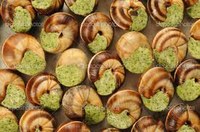About the Warnant snail breeding plant
Why breed snails?
There are less and less snails in Occidental Europe, mainly because of land consolidation, intensive collection and peticides.
Collection has moved to:
- Oriental Europe for the Burgundy snail (Helix pomatia)
- Turkey and the Balkans for the Turkish snail (Helix lucorum)
- South Asia for the Achatina, which is not realy a snail but a big clam which is cut in slices and put back in a snail shell.
Snails were transported in big containers and many of them used to die along the way. This trade was done despite quality and freshness of the product. This contributed to the snails bad reputation with gastronomes. Collection is actually quite severely regulated.
Snail breeding (also called heliciculture) enables to product snails with an incomparable quality as far as taste, texture and freshness are concerned.

At the Warnant snail breeding plant, the full breeding cycle is performed. Also, all the whole processing takes place there, wich is a guarantee of traceability. The young snails are born on site and start growing in hothouses. They are then transfered to the parc where they are fed on a wheat and corn mixture complemented with greenery.
Bredding enables us to produce soft and refined goods.
Our snails are transformed on site in respect with HACCP standards, which ensures freshness and hygenic quality of the products. Our recipies contain quality ingredients: 100% butter Burgundy butter, fresh mushrooms, spices, home-made beers, ...

Why use Helix Aspersa maxima?
We chose to use this variety of snail for its numerous qualities: Helix Aspersa is a specie which can be found around the Mediterranean basin, along the Atlantic, the Channel and the North sea coasts. It can be found up to 200km inland (in Belgium, up to Namur). This specie is naturally finer and more delicate than the other snail species. It is the biggest among the numerous varieties, with weights between 12 and 22 gr. More on http://www.escargotiere.be/